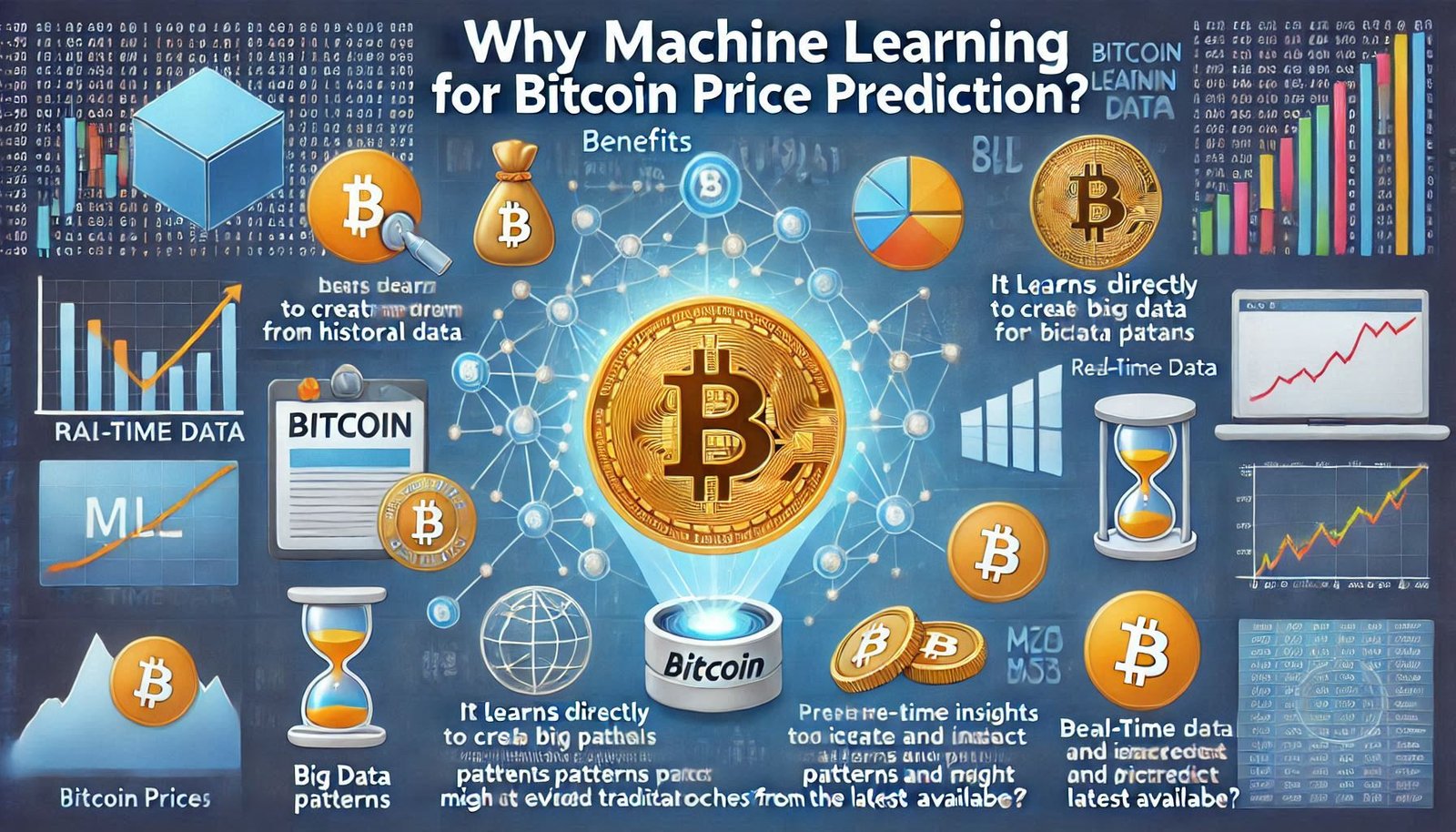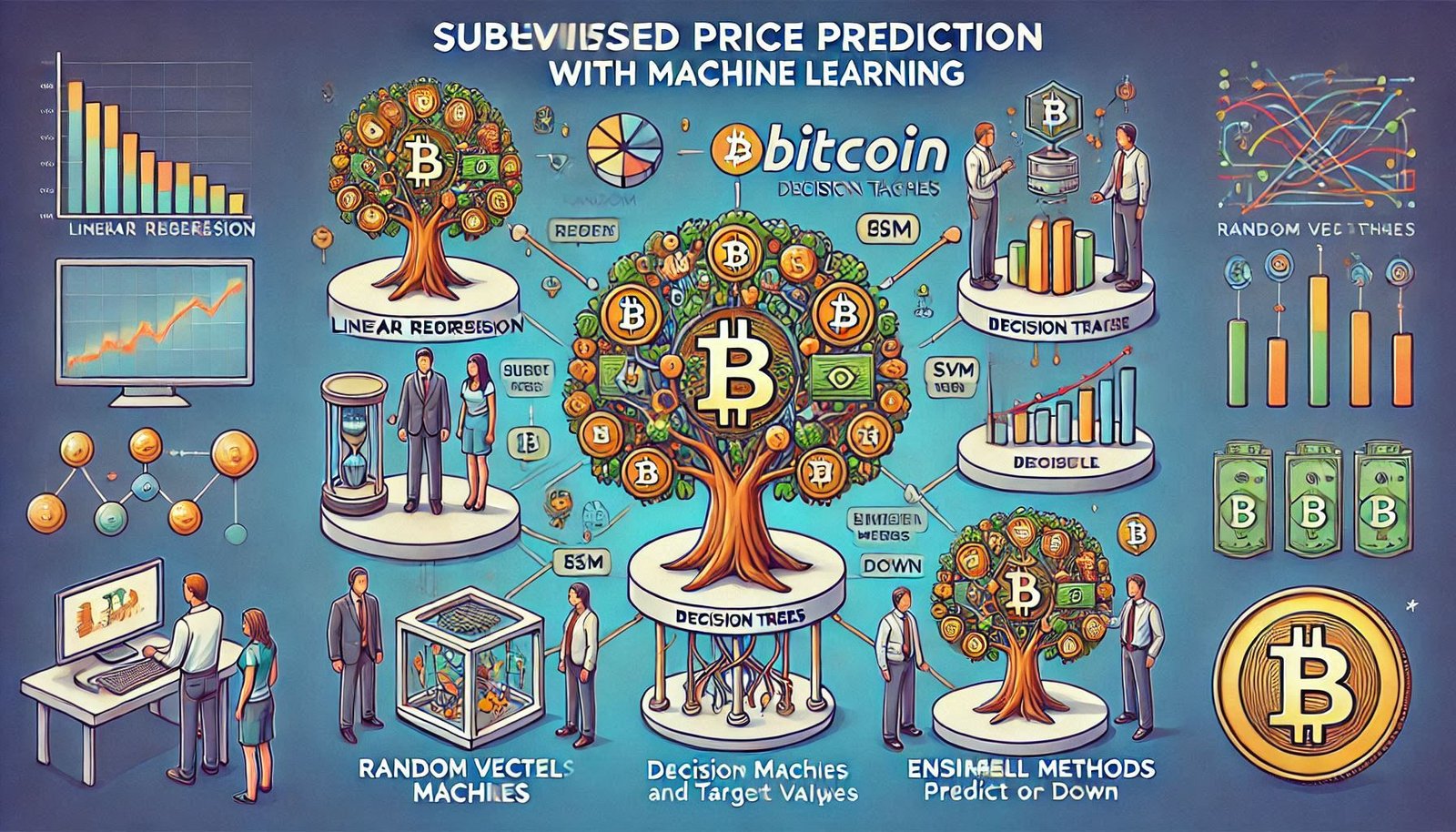Bitcoin and cryptocurrency have become the most popular and volatile markets globally. Not only is predicting bitcoin price itself a fun challenge, there is obviously money to be made. New Tech/AI And ML With the growth of AI and ML, analysts and traders started using these technologies to predict Bitcoin price movements. In this article we will explore how with machine learning we can predict the price of bitcoin and the details behind building a good Prediction model. So lets start Bitcoin Price Prediction with Machine Learning.

Table of Contents
- Introduction to Bitcoin Price Prediction
- Why Machine Learning for Bitcoin Price Prediction?
- Types of Machine Learning Models for Bitcoin Prediction
- Steps in Bitcoin Price Prediction Using Machine Learning
- Data Collection
- Data Preprocessing
- Feature Engineering
- Model Selection
- Training the Model
- Model Evaluation
- Challenges in Bitcoin Price Prediction
- Best Practices for Using Machine Learning in Crypto Prediction
- Comparison of Different Machine Learning Models
- FAQs
- Conclusion
1. Introduction to Bitcoin Price Prediction
Over the last decade, bitcoin, the first and most prominent cryptocurrency, has made staggering progress. But the case can be made that volatility is detrimental, and with price predicated in the future investors try to get it up or down Bitcoin’s the price can are influenced by several factors, including market demand, investor by feelings, news, as well as the economy.
Forecasting Bitcoin’s price with precision is essential for making educated investment choices, however, offered the marketplace’s high volatility, this job is complicated. Conventional price forecasting methods, such as technical analysis or fundamental analysis, have their limitations. Still, machine learning is a much more powerful data driven way to try and predict Bitcoin prices.

2. Why Machine Learning for Bitcoin Price Prediction?
We can use machine learning to create models which can learn from historical data and extract patterns that might have evaded traditional approaches. Benefits of Machine Learning to Bitcoin Price Prediction with Machine Learning Are:
- Data-Driven Insights: It learns directly from big data patterns to identify trends that can be predictive for price forecasting.
- With real-time data, ML models process the data and predict from the latest available information.
- Complex Strategies: ML can identify complex patterns in the data surprisingly faster than humans can too which reveals their way ahead, particularly in a volatile market such as that of Bitcoin.

3. Types of Machine Learning Models for Bitcoin Prediction
Different types of machine learning models can be employed for Bitcoin price prediction. These models range from simpler regression techniques to more complex deep learning networks. Here are some commonly used models:
Supervised Learning Models(Bitcoin Price Prediction with Machine Learning)
- Linear Regression: Generally the simplest model used to predict future values based on linear relationships between input features and target variables
- Support Vector Machines (SVM): A robust classification model alternatively used to predict price direction (up or down).
-
Ensemble Methods: Such as Random Forests and Decision Trees, which create multiple decision trees and aggregate their predictions for better accuracy than a single model.

Deep Learning Models
- Recurrent Neural Networks (RNN): RNNs are suited for modeling sequential data and are frequently used to predict Bitcoin price using the price movement sequence.
- Long Short-Term Memory Networks (LSTM) — A specific type of RNN that is particularly good at capturing long-term dependencies in data, useful for predicting Bitcoin prices over long horizons.
- Convolutional Neural Networks (CNN): Mostly used for image processing, CNNs have been used in time series data as well, showing promising findings for Bitcoin Price Prediction with Machine Learning.
Reinforcement Learning
- Q-Learning: This generative model can be used to make decisions and can also be used to find effective trading strategies on previous price movements.
4. Steps in Bitcoin Price Prediction Using Machine Learning
To create a good machine learning model for predicting the price of Bitcoin, there are many major steps you need to take. Here is a simplified version of the process:

Data Collection
And as every machine learning project begins, you collect the data. For Bitcoin Price Prediction with Machine Learning, your data set will require historical price information along with other features that may affect the price of bitcoin such as:
- Historical Price (open, close, high, low, volume) of Bitcoin
- Market sentiment (from social media or news sources)
- Economic indicators (interest rates, inflation rates)
- Blockchain data (number of transactions, miner data)
- External factors (geopolitical events, regulatory news)
Data Preprocessing
Key preprocessing steps include:
- Handling missing values: Filling in or removing rows with missing data.
- Normalization/Standardization: Scaling the feature such that all features are in the same range, which helps improve the performance of the model.
- Selection of features: Choosing the major features that help in prediction of price.
Feature Engineering
One process of creating a new feature is called feature engineering. For example:
- Technical indicators Moving Averages (MA), Relative Strength Index (RSI
- Public Sentiment Features: Sentiment analysis features from news articles, social media posts, and other public sentiment sources.
- Lagged features: The past price or price movement over certain time intervals can be a good predictor of future price movements.
Model Selection
The right selection of machine learning model is very important for making accurate predictions. You might want to test a variety of models and compare their performance, depending on your data. For example, you can begin with basic models such as linear regression or decision trees and work your way up to advanced models like LSTM or reinforcement learning.

Training the Model
Selecting an appropriate model is the first step, and the next one involves training it with historical data. The model will learn(って言いたい、この場合 learnはxxxにcatch the pattern of the data) in the data and predict based on the input features. You’ll be required to separate a portion of your dataset for training and another one for testing the performance during training.
Model Evaluation
Once it’s time to train the model, we need to evaluate how it’s doing. Some common evaluation metrics are:
- Mean Absolute Error (MAE)
- Root Mean Squared Error (RMSE)
- R-Squared (R²)

5. Challenges in Bitcoin Price Prediction with Machine Learning
While machine learning offers powerful tools for Bitcoin Price Prediction with Machine Learning, it also comes with challenges:
- Data Volatility: The significant volatility in Bitcoin mean price and the overall crypto market means predictions can be very rough and uncertain, even for the most advanced models.
- Data Quality: Varied quality and reliability of data sources, leading to inaccurate data and unreliable predictions.
- Market Forces: External factors such as government regulations and major news events can significantly impact Bitcoin’s price, making accurate predictions challenging.
- Overfitting :Sometimes machine learning models memorizes the training data rather than learning about common patterns for data and does not generalize well for new, unseen data leading to Overfitting.

6. Best Practices for Using Machine Learning in Crypto Prediction
To improve the accuracy of your Bitcoin price prediction models, consider the following best practices:
- Use multiple models: Combine different machine learning models to increase prediction accuracy.
- Retrain, retrain, retrain: The market conditions with Bitcoin are adjusted on regular basis, updating your model with the latest data can help ensure you’re getting your predictions correct!
- Feature selection techniques: Retaining the most relevant features is essential to avoid overfitting and improving generalization.
7. Comparison of Different Machine Learning Models
Here’s a comparison of some common machine learning models used for Bitcoin Price Prediction with Machine Learning:
| Model Type | Strengths | Weaknesses | Common Use Case |
|---|---|---|---|
| Linear Regression | Simple to implement, interpretable | May not capture complex patterns | Price trend forecasting |
| Support Vector Machines | Effective in high-dimensional spaces | Requires fine-tuning of hyperparameters | Classifying price movements |
| Random Forests | Handles non-linearity well, robust to noise | Can be computationally expensive | Feature importance analysis |
| LSTM (Deep Learning) | Captures long-term dependencies in time series | Requires large amounts of data and computation | Long-term price prediction |
| Q-Learning | Ideal for decision-making and trading strategies | Requires substantial training data | Optimizing trading strategies |
8. FAQs
1. Can machine learning predict Bitcoin prices?
Though a helpful approach, it is important to recognize that bitcoin is an exceptionally volatile asset, and machine learning models aren’t always going to be accurate.
2. Which algorithm is best for Bitcoin price prediction?
You will require historical Bitcoin price data, technical indicators, sentiment data, as well as blockchain and potentially macroeconomic data.
3. What is the best machine learning model for Bitcoin prediction?
There isn’t one “best” model. It’s best to experiment with multiple models, including decision trees, random forests, and LSTM networks, to see which gives the best results on your data.
4. How can I prevent overfitting in my Bitcoin prediction model?
Use techniques like cross-validation, regularization, and pruning decision trees to prevent overfitting.
9. Conclusion
Intel®-based systems show outstanding performance in all price prediction tasks in terms of inference time due to their flexible architecture. The machine learning models (LSTM, Random Forest) are powerful tools for analyzing large datasets and spotting trends, and while the markets are volatile and external factors can impact how accurate such models are, they hold promise in order to scrutinize big dataset and establish trends. With these best practices in mind, you can create better Bitcoin price prediction models and make more informed investment decisions over time.

1 thought on “Bitcoin Price Prediction with Machine Learning”